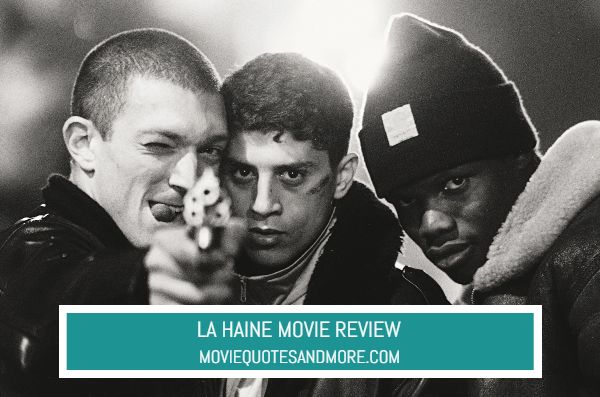By Chase Bennett

To jump off a building and say “so far so good” would be a bit facetious (don’t worry, not a spoiler). For Vinz, Said and Hubert, facetious is their middle name. Raised by the slums, the three friends navigate through the dense political and social climate of Paris following a deadly riot. The humorous but densely serious La Haine captures the essence of tomfoolery juxtaposed with social commentary all packed into one neat 100-minute film. The three boys, consisting of an Arab, an African, and a Jew, offer a perspective of the oppressed that is otherwise unseen in Paris.
This French crime drama directed by Mathieu Kassovitz, shot by Pierre Aim, bites off more than the average can chew and demolishes it with pride. The unique cinematography and direction of La Haine sits notoriously inspired by the French New Wave cinema that made its’ rounds in the late 1950’s-1960’s.
Kassovitz is no stranger to French films. Of course, a French native but he has won three César Awards, two for La Haine alone. His other most notable work is Amelie, another grossly popular French film that follows the life of a young woman orchestrating the lives of those around her. Kassovitz’s work shines through the big screen as he rejects traditional filmmaking in the favor of more experimentation and iconoclasm, both popular in French New Wave cinema.
Though Pierre Aim has not been awarded in recent years, his work on La Haine earned him his own César Award. He has worked on numerous American and French made films throughout the years, showcasing his unique cinematography using depth, composition and high contrast in ways that American film has not scene in a long time. (When you’ve reached the impossible bathroom shot, return to this paragraph and remember what I said about Aim’s work!) Another one of his notable works includes Paris Je T’aime, the story of mythically romantic Paris.
Kassovitz and Aim both tackle the bleakness of impoverished suburbs by shooting the film in black and white. Oh, you didn’t know this was a black and white film? You’ll be excited to see that you never knew a movie could be more about color when there’s a distinct lack thereof. The colorless film helps transcend this film to appear that it may have been shot yesterday or the day before as its messages and visuals remain relevant today. The romanticism of the City of Lights or the brilliant colors of the intricate architecture are stripped away leaving the viewers with a grim view of the reality that encloses them and the characters on screen. There is no sanctuary, no shining beacon of culture in this Paris, only struggle and strength, black and white.
The needle drops in this film are fantastic, packed with old Bob Marley beats and hardcore rap collective Assassin, a group that emerged in the 1980’s who oversee the film’s soundtrack. French rap sets up a forefront for the boys to get up to their nefarious deeds.
Actors Vincent Cassel, Said Taghmaoui and Hubert Koundé all bear the same name as their characters in the film. Is it for realism? Is it simpler? Did Kassovitz forget to name his characters? I can’t say for sure but the one thing the three men do best is be authentic. Their lives jump off the screen as if you know each one of them personally and shaken each of their hands in another life. Each man jumps on the lines of the other as if they have been brothers for years.
Each character is multifaceted and complex as each of their decisions and words conflict with each other. One moment the men may be skipping the street together and the next at each other’s throats. Their flaws and virtues are equally highlighted as they face the hardships of political and social freedom.
Kassovitz, Cassel, Taghmaoui and Koundé all outperformed each other as they strive to bring the vision to life in this chaotic film. The authentic nature of the ensemble of boys helps bring the bleak Paris to life as they clash with the police throughout. Boys will be boys in this film, that one is for certain.
Vincent Cassel, the most well-known actor of the bunch, found himself lost in a sea of TV movies and short films before landing La Haine. His impressionable face, cut like a triangle, brings to life the sharp and gritty life his character leads. Despite being the most popular, most of his work remains in French film aside from another large American made film, Black Swan where he portrays the grim perfectionist director Thomas Leroy.
The genuine friendship of our protagonists reminds me of the film Mid90s, a coming of age film about a group of skateboarders living in 1990s Los Angeles. The lighthearted interactions between the teens seems to appear just as much off screen as it does on screen. The iconic cinematography mimics Citizen Kane in its appeal for something fresh and new that isn’t played out in your run of the mill Hollywood films. If you enjoyed the daredevil and anti-social attitudes of the moody skaters in Mid90s but want to see it shot by Gregg Toland like it’s from the cutting edge of 1941, this film may be for you.
The title of the film La Haine quite literally means hate. Though there is hate written all over the walls, running through the blood of our characters, you cannot help but love that which you see when you watch this French masterpiece. I would highly recommend this film to the movie-goers who can appreciate all aspects of the film medium, not just an exploding car or giant gorillas fighting each other.
Rating: 5/5
